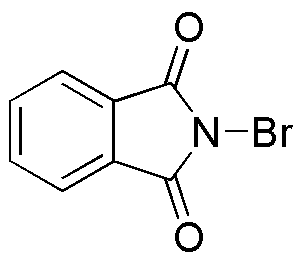N-Bromophthalimide is widely utilized in research focused on:
- Synthetic Chemistry: It serves as a brominating agent in organic synthesis, allowing chemists to introduce bromine into various compounds efficiently. This is particularly useful in the development of pharmaceuticals and agrochemicals.
- Photochemistry: The compound is used in photochemical reactions, enabling researchers to study light-induced processes. Its ability to generate reactive species upon light exposure makes it valuable in the development of photoresponsive materials.
- Polymer Chemistry: N-Bromophthalimide acts as a chain transfer agent in the synthesis of certain polymers. This application helps in controlling molecular weight and enhancing the properties of the final polymer products.
- Analytical Chemistry: It is employed in various analytical techniques, such as fluorescence spectroscopy, to detect and quantify specific analytes. This application is crucial in environmental monitoring and quality control in manufacturing.
- Biochemistry: The compound is used in the modification of biomolecules, aiding in the study of enzyme mechanisms and protein interactions. This application is essential for drug discovery and understanding biological processes.
General Information
Properties
Safety and Regulations
Applications
N-Bromophthalimide is widely utilized in research focused on:
- Synthetic Chemistry: It serves as a brominating agent in organic synthesis, allowing chemists to introduce bromine into various compounds efficiently. This is particularly useful in the development of pharmaceuticals and agrochemicals.
- Photochemistry: The compound is used in photochemical reactions, enabling researchers to study light-induced processes. Its ability to generate reactive species upon light exposure makes it valuable in the development of photoresponsive materials.
- Polymer Chemistry: N-Bromophthalimide acts as a chain transfer agent in the synthesis of certain polymers. This application helps in controlling molecular weight and enhancing the properties of the final polymer products.
- Analytical Chemistry: It is employed in various analytical techniques, such as fluorescence spectroscopy, to detect and quantify specific analytes. This application is crucial in environmental monitoring and quality control in manufacturing.
- Biochemistry: The compound is used in the modification of biomolecules, aiding in the study of enzyme mechanisms and protein interactions. This application is essential for drug discovery and understanding biological processes.
Documents
Safety Data Sheets (SDS)
The SDS provides comprehensive safety information on handling, storage, and disposal of the product.
Product Specification (PS)
The PS provides a comprehensive breakdown of the product’s properties, including chemical composition, physical state, purity, and storage requirements. It also details acceptable quality ranges and the product's intended applications.
Certificates of Analysis (COA)
Search for Certificates of Analysis (COA) by entering the products Lot Number. Lot and Batch Numbers can be found on a product’s label following the words ‘Lot’ or ‘Batch’.
*Catalog Number
*Lot Number
Certificates Of Origin (COO)
This COO confirms the country where the product was manufactured, and also details the materials and components used in it and whether it is derived from natural, synthetic, or other specific sources. This certificate may be required for customs, trade, and regulatory compliance.
*Catalog Number
*Lot Number
Safety Data Sheets (SDS)
The SDS provides comprehensive safety information on handling, storage, and disposal of the product.
DownloadProduct Specification (PS)
The PS provides a comprehensive breakdown of the product’s properties, including chemical composition, physical state, purity, and storage requirements. It also details acceptable quality ranges and the product's intended applications.
DownloadCertificates of Analysis (COA)
Search for Certificates of Analysis (COA) by entering the products Lot Number. Lot and Batch Numbers can be found on a product’s label following the words ‘Lot’ or ‘Batch’.
*Catalog Number
*Lot Number
Certificates Of Origin (COO)
This COO confirms the country where the product was manufactured, and also details the materials and components used in it and whether it is derived from natural, synthetic, or other specific sources. This certificate may be required for customs, trade, and regulatory compliance.


